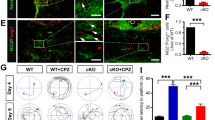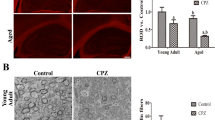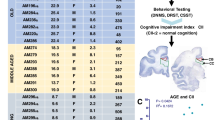Abstract
During aging, there is a decrease both in the stability of central nervous system (CNS) myelin once formed and in the efficiency of its repair by oligodendrocytes (OLs). To study CNS remyelination during aging, we used the cuprizone (a copper chelator) mouse model. Inclusion of cuprizone in the diet kills mature OLs and demyelinates axons in the rostral corpus callosum (CC) of mice, which enabled us to characterize age-related changes (i.e., 2–16 months of age) in glial cell response during the recruitment (i.e., demyelination) and differentiation (i.e., remyelination) phases of myelin repair. We have found that the time between 12 and 16 months of age is a critical period during which there is an age-related decrease in the number of OL lineage cells (Olig2Nuc+ve/GFAP−ve cells) in the rostral CC of both control mice and mice recovering from cuprizone-induced demyelination. Our results also show there was an age-related impaired recruitment of progenitor cells to replace lost OLs in spite of there being no major age-related decrease in the size of the progenitor cell pool (PDGFαR+ve/GFAP−ve, and Olig2Nuc +ve/PDGFαR+ve cells). However, there were cuprizone-induced increased numbers of astrocyte progenitor cells (Olig2Cyto+ve/PDGFαR+ve) in these same mice; thus PDGFαR+ve progenitor cells in mice as old as 16 months of age retain the ability to differentiate into astrocytes, with this fate choice occurring following cytoplasmic translocation of Olig2. These data reveal for the first time age-related differences in the differentiation of PDGFαR+ve progenitor cells into OLs and astrocytes and lead us to suggest that during aging there must be a transcriptional switch mechanism in the progenitor cell fate choice in favor of astrocytes. This may at least partially explain the age-related decrease in efficiency of OL myelination and remyelination.











Similar content being viewed by others
References
Ando S, Tanaka Y, Toyoda Y, Kon K (2003) Turnover of myelin lipids in aging brain. Neurochem Res 28:5–13
Armstrong RC, Le TQ, Frost EE, Borke RC, Vana AC (2002) Absence of fibroblast growth factor 2 promotes oligodendroglial repopulation of demyelinated white matter. J Neurosci 22:8574–8585
Arnett HA, Fancy SP, Alberta JA, Zhao C, Plant SR, Kaing S, Raine CS, Rowitch DH, Franklin RJ, Stiles CD (2004) bHLH transcription factor Olig1 is required to repair demyelinated lesions in the CNS. Science 306:2111–2115
Bakker DA, Ludwin SK (1987) Blood-brain barrier permeability during Cuprizone-induced demyelination. Implications for the pathogenesis of immune-mediated demyelinating diseases. J Neurol Sci 78:125–137
Bartzokis G (2004a) Age-related myelin breakdown: a developmental model of cognitive decline and Alzheimer’s disease. Neurobiol Aging 25:5–18 author reply 49–62
Bartzokis G (2004b) Author’s response to commentaries. Quadratic trajectories of brain myelin content: unifying construct for neuropsychiatric disorders. Neurobiol Aging 25:49–62
Bartzokis G, Sultzer D, Lu PH, Nuechterlein KH, Mintz J, Cummings JL (2004a) Heterogeneous age-related breakdown of white matter structural integrity: implications for cortical “disconnection” in aging and Alzheimer’s disease. Neurobiol Aging 25:843–851
Bartzokis G, Tishler TA, Shin IS, Lu PH, Cummings JL (2004b) Brain ferritin iron as a risk factor for age at onset in neurodegenerative diseases. Ann N Y Acad Sci 1012:224–236
Benes FM (2004) A disturbance of late myelination as a trigger for Alzheimer’s disease. Neurobiol Aging 25:41–43
Blakemore WF, Crang AJ (1988) Extensive oligodendrocyte remyelination following injection of cultured central nervous system cells into demyelinating lesions in adult central nervous system. Dev Neurosci 10:1–11
Blakemore WF, Crang AJ, Franklin RJM (1990) Transplantation of glial cell cultures into areas of demyelination in the adult CNS. Prog Brain Res 82:225–232
Boyd JG, Lee J, Skihar V, Doucette R, Kawaja MD (2004) LacZ-expressing olfactory ensheathing cells do not associate with myelinated axons after implantation into the compressed spinal cord. Proc Natl Acad Sci U S A 101:2162–2166
Braak H, Del Tredici K (2004) Poor and protracted myelination as a contributory factor to neurodegenerative disorders. Neurobiol Aging 25:19–23
Carey EM, Freeman NM (1983) Biochemical changes in Cuprizone-induced spongiform encephalopathy. I. Changes in the activities of 2′,3′-cyclic nucleotide 3′-phosphohydrolase, oligodendroglial ceramide galactosyl transferase, and the hydrolysis of the alkenyl group of alkenyl, acyl-glycerophospholipids by plasmalogenase in different regions of the brain. Neurochem Res 8:1029–1044
Cassiani-Ingoni R, Coksaygan T, Xue H, Reichert-Scrivner SA, Wiendl H, Rao MS, Magnus T (2006) Cytoplasmic translocation of Olig2 in adult glial progenitors marks the generation of reactive astrocytes following autoimmune inflammation. Exp Neurol 201:349–358
Chari DM, Crang AJ, Blakemore WF (2003) Decline in rate of colonization of oligodendrocyte progenitor cell (OPC)-depleted tissue by adult OPCs with age. J Neuropathol Exp Neurol 62:908–916
Collarini EJ, Pringle N, Mudhar H, Stevens G, Kuhn R, Monuki ES, Lemke G, Richardson WD (1991) Growth factors and transcription factors in oligodendrocyte development. J Cell Sci Suppl 15:117–123
Connor JR (2004) Myelin breakdown in Alzheimer’s disease: a commentary. Neurobiol Aging 25:45–47
Franklin RJ, Zhao C, Sim FJ (2002) Ageing and CNS remyelination. Neuroreport 13:923–928
Fukuda S, Kondo T, Takebayashi H, Taga T (2004) Negative regulatory effect of an oligodendrocyte bHLH factor OLIG2 on the astrocytic differentiation pathway. Cell Death Differ 11:196–202
Gokhan S, Marin-Husstege M, Yung SY, Fontanez D, Casaccia-Bonnefil P, Mehler M (2005) Combinatorial profiles of oligodendrocyte-selective classes of transcriptional regulators differentially modulate myelin basic protein gene expression. J Neurosci 25:8311–8321
Hall SM (1972) The effect of injections of lysophosphatidyl choline into white matter of the adult mouse spinal cord. J Cell Sci 10:535–546
Hao Z, Yeung J, Wolf L, Doucette R, Nazarali A (1999) Differential expression of Hoxa-2 protein along the dorsal-ventral axis of the developing and adult mouse spinal cord. Dev Dyn 216:201–217
Herndon RM, Price DL, Weiner LP (1977) Regeneration of oligodendroglia during recovery from demyelinating disease. Science 195:693–694
Hinks GL, Franklin RJ (2000) Delayed changes in growth factor gene expression during slow remyelination in the CNS of aged rats. Mol Cell Neurosci 16:542–556
Hiremath MM, Saito Y, Knapp GW, Ting JP, Suzuki K, Matsushima GK (1998) Microglial/macrophage accumulation during cuprizone-induced demyelination in C57BL/6 mice. J Neuroimmunol 92:38–49
Islam MS, Tatsumi K, Okuda H, Shiosaka S, Wanaka A (2009) Olig2-expressing progenitor cells preferentially differentiate into oligodendrocytes in cuprizone-induced demyelinated lesions. Neurochem Internat 54:192–198
Jurevics H, Largent C, Hostettler J, Sammond DW, Matsushima GK, Kleindienst A, Toews AD, Morell P (2002) Alterations in metabolism and gene expression in brain regions during cuprizone-induced demyelination and remyelination. J Neurochem 82:126–136
Knobler RL, Stempak JG, Laurencin M (1974) Oligodendroglial ensheathment of axons during myelination in the developing rat central nervous system. A serial section electron microscopical study. J Ultrastruct Res 49:34–49
Komoly S, Hudson LD, Webster HD, Bondy CA (1992) Insulin-like growth factor I gene expression is induced in astrocytes during experimental demyelination. Proc Natl Acad Sci USA 89:1894–1898
Kondo A, Nakano T, Suzuki K (1987) Blood–brain barrier permeability to horseradish peroxidase in twitcher and cuprizone-intoxicated mice. Brain Res 425:186–190
Lang W, Rodriguez M, Lennon VA, Lampert PW (1984) Demyelination and remyelination in murine viral encephalomyelitis. Ann N Y Acad Sci 436:98–102
Labombarda F, González SL, Lima A, Roig P, Guennoun R, Schumacher M, de Nicola AF (2009) Effects of progesterone on oligodendrocyte progenitors, oligodendrocyte transcription factors, and myelin proteins following spinal cord injury. Glia 57:884–897
Ludwin SK (1978) Central nervous system demyelination and remyelination in the mouse: an ultrastructural study of cuprizone toxicity. Lab Invest 39:597–612
Ludwin SK (1979) An autoradiographic study of cellular proliferation in remyelination of the central nervous system. Am J Pathol 95:683–696
Ludwin SK (1980) Chronic demyelination inhibits remyelination in the central nervous system. An analysis of contributing factors. Lab Invest 43:382–387
Ludwin SK, Sternberger NH (1984) An immunohistochemical study of myelin proteins during remyelination in the central nervous system. Acta Neuropathol (Berl) 63:240–248
Lyman WD, Brosnan CF, Raine CS (1985) Chronic-relapsing experimental autoimmune encephalomyelitis. Myelin basic protein induces suppression of blastogenesis during remissions but not during exacerbations. J Neuroimmunol 7:345–353
Magnus T, Coksaygan T, Korn T, Xue H, Arumugam TV, Mughal MR, Eckley DM, Tang SC, DeTolla L, Rao MS, Cassiani-Ingoni R, Mattson MP (2007) Evidence that nucleocytoplasmic Olig2 translocation mediates brain-injury-induced differentiation of glial precursors to astrocytes. J Neurosci Res 85:2126–2137
Mason JL, Xuan S, Dragatsis I, Efstratiadis A, Goldman JE (2003) Insulin-like growth factor (IGF) signaling through type 1 IGF receptor plays an important role in remyelination. J Neurosci 23:7710–7718
Matsushima GK, Morell P (2001) The neurotoxicant, cuprizone, as a model to study demyelination and remyelination in the central nervous system. Brain Pathol 11:107–116
Morell P, Barrett CV, Mason JL, Toews AD, Hostettler JD, Knapp GW, Matsushima GK (1998) Gene expression in brain during cuprizone-induced demyelination and remyelination. Mol Cell Neurosci 12:220–227
Nicolay D, Doucette R, Nazarali A (2007) Transcriptional control of oligodendrogenesis. Glia 55:1287–1299
Noble M (2004) The possible role of myelin destruction as a precipitating event in Alzheimer’s disease. Neurobiol Aging 25:25–31
Peters A (2002a) Structural changes that occur during normal aging of primate cerebral hemispheres. Neurosci Biobehav Rev 26:733–741
Peters A (2002b) The effects of normal aging on myelin and nerve fibers: a review. J Neurocytol 31:581–593
Peters A, Sethares C (2002) Aging and the myelinated fibers in prefrontal cortex and corpus callosum of the monkey. J Comp Neurol 442:277–291
Rist JM, Franklin RJ (2008) Taking ageing into account in remyelination-based therapies for multiple sclerosis. J Neurol Sci 274:64–67
Rivers LM, Young KM, Rizzi M, Jamen F, Psachoulia K, Wade A, Kessaris N, Richardson WD (2008) PDGFRA/NG2 glia generate myelinating oligodendrocytes and piriform projection neurons in adult mice. Nature Neurosci 11:1392–1401
Sandell JH, Peters A (2002) Effects of age on the glial cells in the rhesus monkey optic nerve. J Comp Neurol 445:13–28
Setoguchi T, Kondo T (2004) Nuclear export of OLIG2 in neural stem cells is essential for ciliary neurotrophic factor-induced astrocyte differentiation. J Cell Biol 166:963–968
Shen S, Sandoval J, Swiss VA, Li J, Dupree J, Franklin RJ, Casaccia-Bonnefil P (2008) Age-dependent epigenetic control of differentiation inhibitors is critical for remyelination efficiency. Nature Neurosci 11:1024–1034
Sim FJ, Zhao C, Penderis J, Franklin RJ (2002) The age-related decrease in CNS remyelination efficiency is attributable to an impairment of both oligodendrocyte progenitor recruitment and differentiation. J Neurosci 22:2451–2459
Sloane JA, Hinman JD, Lubonia M, Hollander W, Abraham CR (2003) Age-dependent myelin degeneration and proteolysis of oligodendrocyte proteins is associated with the activation of calpain-1 in the rhesus monkey. J Neurochem 84:157–168
Stidworthy MF, Genoud S, Suter U, Mantei N, Franklin RJ (2003) Quantifying the early stages of remyelination following cuprizone-induced demyelination. Brain Pathol 13:329–339
Sun T, Dong H, Wu L, Kane M, Rowitch DH, Stiles CD (2003) Cross-repressive interaction of the Olig2 and Nkx2.2 transcription factors in developing neural tube associated with formation of a specific physical complex. J Neurosci 23:9547–9556
Tochitani S, Hayashizaki Y (2008) Nkx2.2 antisense RNA overexpression enhanced oligodendrocytic differentiation. Biochem Biophys Res Commun 372:691–696
Watanabe M, Hadzic T, Nishiyama A (2004) Transient upregulation of Nkx2.2 expression in oligodendrocyte lineage cells during remyelination. Glia 46:311–322
Wegner M (2000a) Transcriptional control in myelinating glia: flavors and spices. Glia 31:1–14
Wegner M (2000b) Transcriptional control in myelinating glia: the basic recipe. Glia 29:118–123
Wegner M (2001) Expression of transcription factors during oligodendroglial development. Microsc Res Tech 52:746–752
Wei Q, Miskimins WK, Miskimins R (2005) Stage-specific expression of myelin basic protein in oligodendrocytes involves Nkx2.2-mediated repression that is relieved by the Sp1 transcription factor. J Biol Chem 280:16284–16294
Yajima K, Suzuki K (1979) Ultrastructural changes of oligodendroglia and myelin sheaths induced by ethidium bromide. Neuropathol Appl Neurobiol 5:49–62
Zeller NK, Behar TN, Dubois-Dalcq ME, Lazzarini RA (1985) The timely expression of myelin basic protein gene in cultured rat brain oligodendrocytes is independent of continuous neuronal influences. J Neurosci 5:2955–2962
Zhao J-W, Raha-Chowdhury R, Fawcett JW, Watts C (2009) Astrocytes and oligodendrocytes can be generated from NG2 + progenitors after acute brain injury: intracellular localization of oligodendrocyte transcription factor 2 is associated with their fate choice. Eur J Neurosci 29:1853–1869
Acknowledgments
This project was supported by an operating grant from the Canadian Institutes of Health Research (to AN and RD) and by a Pilot Project Grant from the Cameco Multiple Sclerosis Neuroscience Research Center (to RD and AN). We thank Dr. Collette Wheeler and Ms. Michele Moroz for their assistance and guidance in monitoring the health status of the mice. Special thanks are also due to R. Sobchishin and M. Basiri for technical assistance. We are also grateful to Drs. M. Gardinier and H. Takebayashi for providing the mouse monoclonal antibody to MOG and the rabbit polycolonal antibody to Olig2, respectively.
Author information
Authors and Affiliations
Corresponding author
Rights and permissions
About this article
Cite this article
Ronald Doucette, J., Jiao, R. & Nazarali, A.J. Age-Related and Cuprizone-Induced Changes in Myelin and Transcription Factor Gene Expression and in Oligodendrocyte Cell Densities in the Rostral Corpus Callosum of Mice. Cell Mol Neurobiol 30, 607–629 (2010). https://doi.org/10.1007/s10571-009-9486-z
Received:
Accepted:
Published:
Issue Date:
DOI: https://doi.org/10.1007/s10571-009-9486-z




